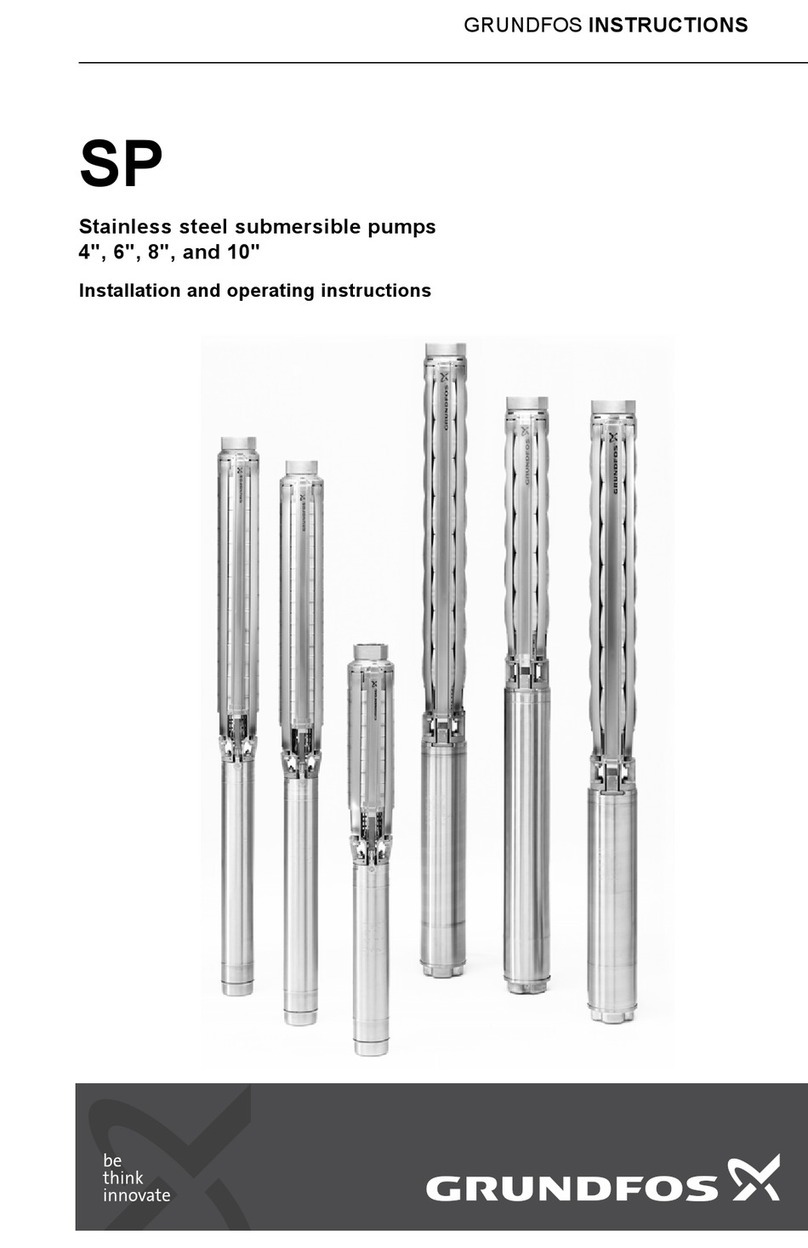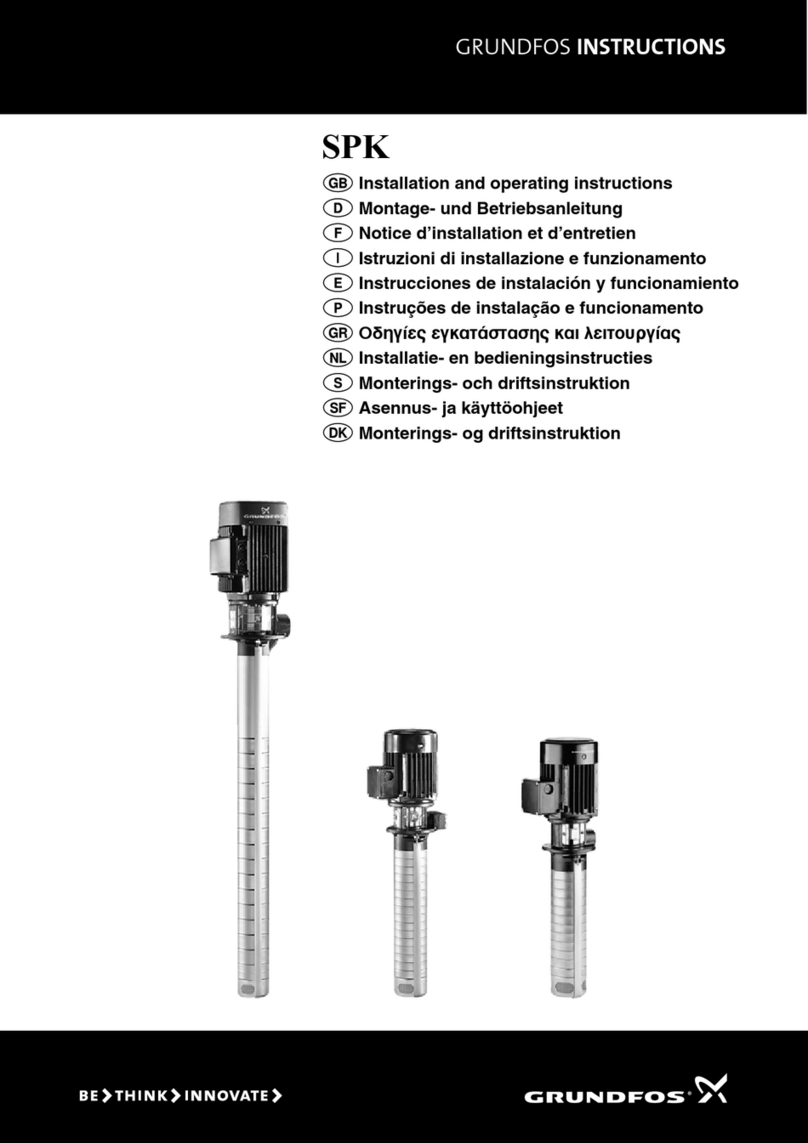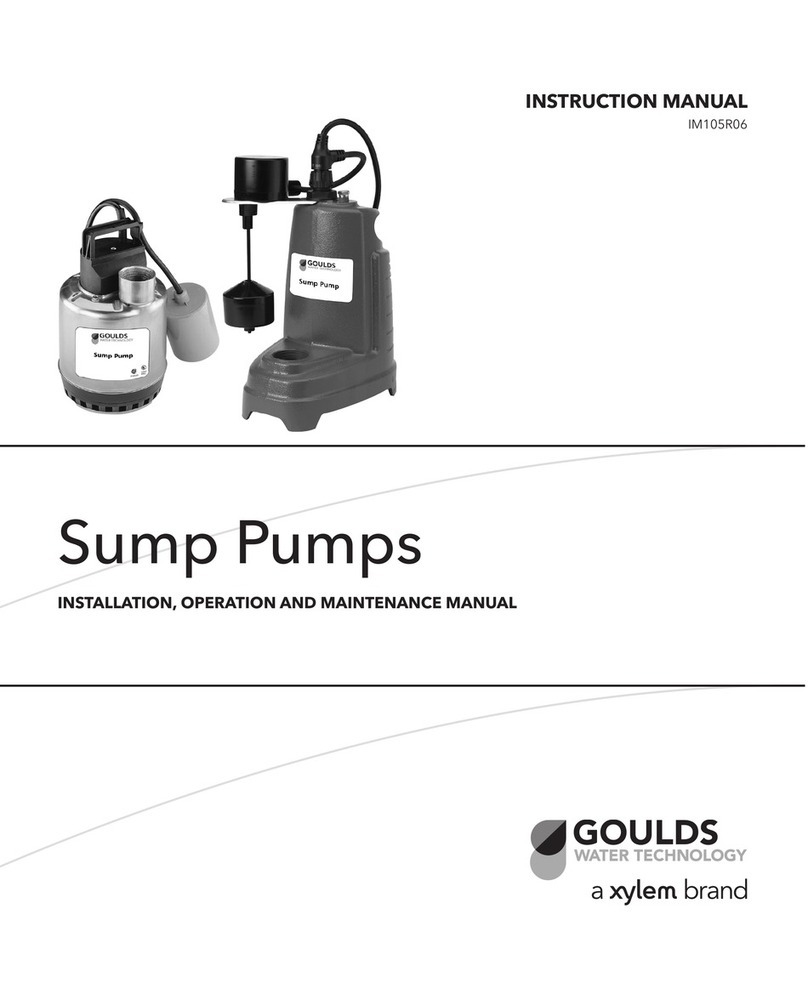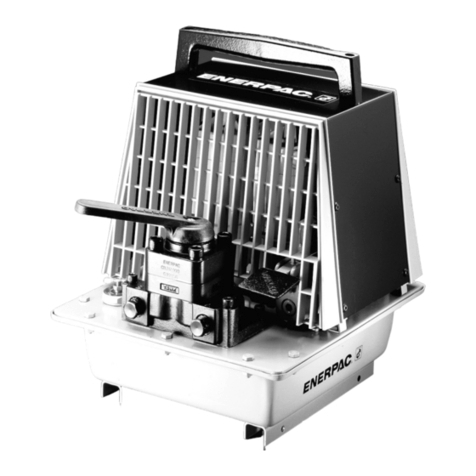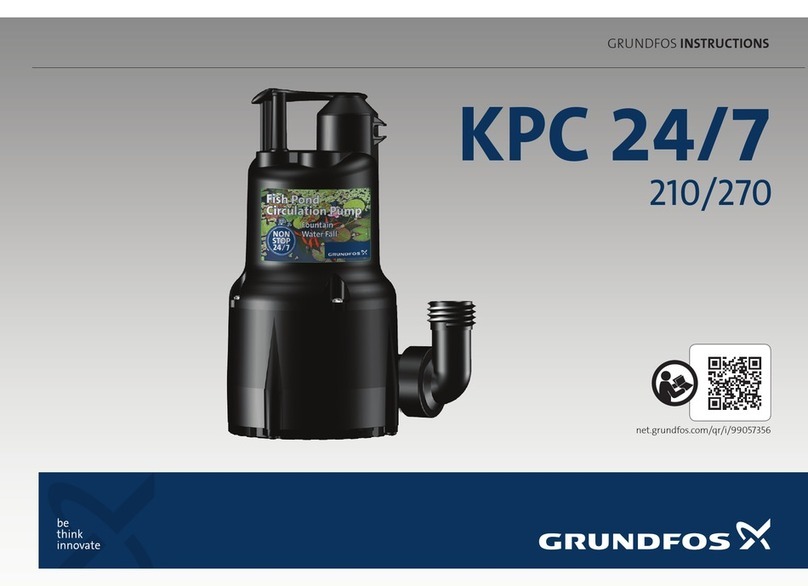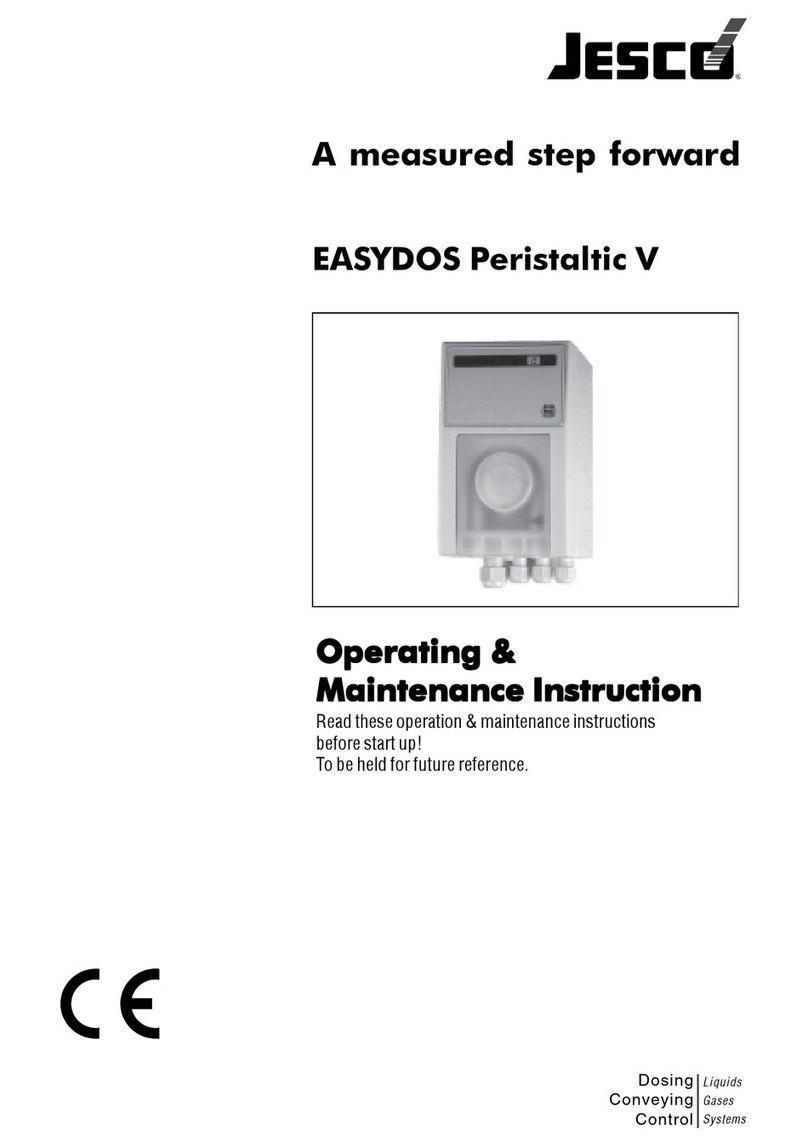Berkley Tool SSHM-2 User manual

OWNER’S MANUAL
Self-Priming Horizontal
Multistage Pump
Installation/Operation/Parts
For further operating, installation, or maintenance assistance:
Call 1-888-237-5353
© 2007 BE682 (Rev. 12/3/08)
SSHM-2
293 Wright St., Delavan WI 53115

Safety 2
READ AND FOLLOW
SAFETY INSTRUCTIONS!
This is the safety alert symbol. When you see this
symbol on your pump or in this manual, look for
one of the following signal words and be alert to the
potential for personal injury:
warns about hazards that will cause serious
personal injury, death or major property damage if
ignored.
warns about hazards that can cause serious
personal injury, death or major property damage if
ignored.
warns about hazards that will or can cause
minor personal injury or property damage if ignored.
The label NOTICE indicates special instructions which
are important but not related to hazards.
Carefully read and follow all safety instructions in this
manual and on pump.
Keep safety labels in good condition.
Replace missing or damaged safety labels.
ELECTRICAL SAFETY
Wire motor for correct
voltage. See “Electrical”
section of this manual and
motor nameplate.
Ground motor before
connecting to power
supply.
Meet National Electrical
Code, Canadian Electri-
cal Code, and local codes for
all wiring.
Follow wiring instruc-
tions in this manual
when connecting motor to
power lines.
Make workshops childproof; use padlocks and master
switches; remove starter keys.
Do not touch an operating motor. Modern
motors can operate at high temperatures. To avoid burns
when servicing pump, allow it to cool for 20 minutes
after shut-down before handling.
GENERAL SAFETY
To avoid heat built-up in pump, over pressure hazard and
possible injury, do not use in a pressure tank (domestic
water) system. Do not use as a booster pump; pressurized
suction may cause pump body to explode.
Do not allow pump or piping system to freeze. Freezing
can damage pump and pipe, may lead to injury from
equipment failure and will void warranty.
Pump water only with this pump.
Periodically inspect pump and system components.
Wear safety glasses at all times when working on pumps.
Keep work area clean, uncluttered and properly lighted;
store properly all unused tools and equipment.
Keep visitors at a safe distance from the work areas.
Maximum inlet pressure .........................................30 psi
Maximum operating pressure ...............................130 psi
Maximum liquid temperature ................................120° F
Maximum motor starts per hour...................................15
WARNING
Hazardous pressure!
Do not run pump against
closed discharge.
Release all pressure on
system before working on
any component.
WARNING
Hazardous voltage.
Can shock, burn, or
cause death.
Ground pump before
connecting to power
supply.

Table of Contents 3
Thank you for purchasing a top quality, factory tested pump.
Page
General Safety .....................................................................................................2
Warranty ..............................................................................................................3
Installation........................................................................................................4-6
Electrical..........................................................................................................6, 7
Operation ............................................................................................................8
Maintenance ...................................................................................................9-11
Troubleshooting..................................................................................................11
Repair Parts .......................................................................................................12
LIMITED WARRANTY
BERKELEY warrants to the original consumer purchaser (“Purchaser” or “You”) of the products listed below, that they will
be free from defects in material and workmanship for the Warranty Period shown below.
Product Warranty Period
Water Systems Products — jet pumps,
whichever occurs first:
small centrifugal pumps, submersible pumps 12 months from date of original installation, or
and related accessories 18 months from date of manufacture
Hydro-Flow Filters 1 year from date of purchase
Signature 2000®Fibrewound Tanks 5 years from date of original installation
Pro-SourceTM Steel Pressure Tanks 5 years from date of original installation
Pro-SourceTM Epoxy-Lined Tanks 3 years from date of original installation
Sump/Sewage/Effluent Products 12 months from date of original installation, or
18 months from date of manufacture
Our warranty will not apply to any product that, in our sole judgement, has been subject to negligence, misapplication,
improper installation, or improper maintenance. Without limiting the foregoing, operating a three phase motor with single
phase power through a phase converter will void the warranty. Note also that three phase motors must be protected by
three-leg, ambient compensated, extra-quick trip overload relays of the recommended size or the warranty is void.
Your only remedy, and BERKELEY’s only duty, is that BERKELEY repair or replace defective products (at BERKELEY’s
choice). You must pay all labor and shipping charges associated with this warranty and must request warranty service
through the installing dealer as soon as a problem is discovered. No request for service will be accepted if received after
the Warranty Period has expired. This warranty is not transferable.
BERKELEY SHALL NOT BE LIABLE FOR ANY CONSEQUENTIAL, INCIDENTAL, OR CONTINGENT DAMAGES
WHATSOEVER.
THE FOREGOING WARRANTIES ARE EXCLUSIVE AND IN LIEU OF ALL OTHER EXPRESS AND IMPLIED
WARRANTIES, INCLUDING BUT NOT LIMITED TO THE IMPLIED WARRANTIES OF MERCHANTABILITY AND
FITNESS FOR A PARTICULAR PURPOSE. THE FOREGOING WARRANTIES SHALL NOT EXTEND BEYOND THE
DURATION EXPRESSLY PROVIDED HEREIN.
Some states do not allow the exclusion or limitation of incidental or consequential damages or limitations on the duration
of an implied warranty, so the above limitations or exclusions may not apply to You. This warranty gives You specific legal
rights and You may also have other rights which vary from state to state.
This warranty supersedes and replaces all previous warranty publications.
In the U.S.: BERKELEY, 293 Wright St., Delavan, WI 53115
In Canada: Pentair Canada, Inc., 269 Trillium Dr., Kitchener, Ontario N2G 4W5

Installation 4
BEFORE YOU INSTALL YOUR PUMP
NOTICE: Well must not be more than 20' depth to water.
1. Long runs and many fittings increase friction and reduce flow. Locate
pump as close to well as possible: use as few elbows and fittings as
possible.
2. Be sure well is clear of sand. Sand will plug the pump and void the
warranty.
3. Protect pump and all piping from freezing. Freezing will split pipe, dam-
age pump and void the warranty. Check locally for frost protection
requirements (usually pipe must be 12" below frost line and pump must
be insulated).
4. Be sure all pipes and foot valve are clean and in good shape.
5. No air pockets in suction pipe.
6. No leaks in suction pipe. Use Teflon tape or Plasto-Joint Stik to seal pipe
joints.
7. Unions installed near pump and well will aid in servicing. Leave room
to use wrenches.
8. Pump body may explode if used as a booster pump. DO
NOT use in a booster application.
NOTICE: Use the installation method on page 5 which matches your
well type.
9. Install a check valve in the pump suction port. Be sure that the flow
arrow points toward the pump. Failure to install a check valve on the
inlet side of the pump may allow the pump body to drain between
pump cycles, causing dry running, seal or internal failure, and voiding
the warranty.
1
Pump
Body
From
Well
Dirt and Scale Plug Pump and Pipes!
Use New Pipe for Best Results.
Clean Flow!
Figure 1 – No Dirt or Scale in Suction
Pipe
Figure 2 – Foot Valve Must Work
Freely
Figure 3 – No Air Pockets in Suction
Pipe
No Sags
Sags Allow Air Pockets
If Air Pockets Form, Water Won’t Flow.
Keep Pipe Straight and Angled up to Pump.
1101 069
7
No Air Leaks In
Suction Pipe.
If Air Flows
Water Won’t
Use Teflon Tape.
Use Teflon Tape Or Pipe Joint
Compound Approved For Use On PVC.
Figure 4 – Suction Pipe Must Not Leak

Installation 5
CASED WELL INSTALLATION
1. Inspect foot valve to be sure it works freely. Inspect strainer to be sure it
is clean.
2. Connect foot valve and strainer to the first length of suction pipe and
lower pipe into well. Add sections of pipe as needed, using Teflon tape
on male threads. Be sure that all suction pipe is leakproof or pump will
lose prime and fail to pump. Install foot valve 10 to 20 feet below the
lowest level to which water will drop while pump is operating (pump-
ing water level). Your well driller can furnish this information.
3. To prevent sand and sediment from entering the pumping system, the foot
valve/strainer should be at least 5 feet above the bottom of the well.
4. When the proper depth is reached, install a sanitary well seal over the
pipe and in the well casing. Tighten the bolts to seal the casing.
5. When using a foot valve, a priming tee and plug as shown in Figure 5
are recommended.
DUG WELL INSTALLATION
Same as cased well installation.
DRIVEN POINT INSTALLATION
1. Connect the suction pipe to the drive point as illustrated in Figure 6.
Keep horizontal pipe run as short as possible. Use Teflon tape on male
pipe threads. Multiple well points may be necessary to provide suffi-
cient water to pump.
2. Install a check valve in horizontal pipe. Flow arrow on check valve
must point toward pump.
HORIZONTAL PIPING FROM WELL TO PUMP
1. Never install a suction pipe that is smaller than the suction port of the
pump.
2. To aid priming on well point installations, install a line check valve as
shown in Figure 6. Be sure check valve flow arrow points toward pump.
DISCHARGE PIPE SIZES
1. If increasing discharge pipe size, install reducer in pump discharge port.
Do not increase pipe size by stages.
2. When the pump is set away from the points of water use, the discharge
pipe size should be increased to reduce pressure losses caused by
friction.
• Up to 100' run: Same size as pump discharge port.
• 100' to 300' run: Increase one pipe size.
• 300' to 600' run: Increase two pipe sizes.
SPRINKLING APPLICATION
This pump is designed to deliver plenty of water at full sprinkler pressure. It can
pump from a pond, cistern or well points.
Pump discharge can be divided to supply two (2) or more sprinkler systems.
A suggested multiple discharge to service is shown in Figure 7.
Do not use in a pressure tank or booster pump application.
Suction
pipe
Foot
Valve
Priming plug
Priming tee
Standing water
level (pump off)
Drawdown water
level (pump on)
10-20' (3-6 m)
20' (6 m) max.
At least 5 feet (1.5 m)
828 0993
Figure 5 – Cased/Dug Well Installation
Check valve
Steel drive pipe
Drive coupling
Driven point
745 0993
Figure 6 – Driven Point Installation
4326 0203
Gate
Valve
Gate
Valve
To
Service
To
Service
Priming
Plug
Check
Valve
Figure 7 – Multiple Discharge

Installation 6
PUMP INSTALLATION
Make sure that all pipe joints in the suction pipe are air tight as well as
water tight.
If the suction pipe can suck air, the pump will not be able to
pull water from the well.
1. Bolt pump to solid, level foundation.
2. Support all piping connected to the pump.
3. Wrap 1-1/2 to two layers of Teflon tape clockwise (as you face end of
pipe) on all male threads being attached to pump.
4. Tighten joints hand tight plus 1-1/2 turns. Do not overtighten.
NOTICE: Install pump as close to well head as possible. Long piping runs
and many fittings create friction and reduce flow.
NOTICE: For long horizontal pipe runs, install a priming tee between
check valve and well head as shown in Figure 6. For driven point installa-
tions, install a check valve as shown in Figure 6. Be sure check valve flow
arrow points toward pump.
Use schedule 80 or iron pipe. See “Well Pipe Installation” for more
information.
WIRING
Ground motor before connecting to electrical power supply. Failure to
ground motor can cause severe or fatal electrical shock hazard.
Do not ground to a gas supply line.
To avoid dangerous or fatal electrical shock, turn OFF power to motor
before working on electrical connections.
Supply voltage must be within ±10% of nameplate voltage. Incorrect
voltage can cause fire or damage motor and voids warranty. If in
doubt consult a licensed electrician.
Use wire size specified in Wiring Chart (Page 7). If possible, connect
pump to a separate branch circuit with no other appliances on it.
Wire motor as shown (Page 7). If motor nameplate diagram does not
match either Figure 12A or 12B, follow nameplate diagram.
Figure 8 – Bolt Pump Down
4322 0203
Figure 9 – Independently Support All
Piping Attached to Pump
4323 0203
Figure 10 – Use Teflon tape or Plasto-Joint Stik1on pipe
joints and connections to pump.
1Lake Chemical Co., Chicago, IL
No Air Leaks In
Suction Pipe.
If Air Flows
Water Won’t
Use Teflon Tape.
Use Teflon Tape Or Pipe Joint
Compound Approved For Use On PVC.
Figure 11 – Don’t overtighten.
748 0993
Don’t Hit
Thread Stops
Don’t
Overtighten
From
Well
Pump
Body
Hand Tight Plus 1-1/2 Turns With Wrench.

Electrical 7
Connection Diagram for Single-Phase Motors
Your motor’s terminal board (under the motor end cover) should match the
diagram in Figure 12A or 12B.
For single-phase motors, follow Figure 12A. For 3-phase motors, follow
Figure 12B. If motor does not match this picture, follow the connection
diagram on the motor nameplate or in the motor connection box.
Hazardous voltage. Can shock, burn, or cause death.
Disconnect power to motor before working on pump or motor. Ground
motor before connecting to power supply.
1. Install, ground, wire and maintain this pump in accordance with electri-
cal code requirements. Consult your local building inspector for infor-
mation about codes.
2. Provide a correctly fused disconnect switch for protection while working on
motor. Consult local or national electrical codes for switch requirements.
3. Disconnect power before servicing motor or pump. If the disconnect
switch is out of sight of pump, lock it open and tag it to prevent unex-
pected power application.
4. Ground the pump permanently using a wire of the same size as that
specified in wiring chart (below). Make ground connection to green
grounding terminal under motor canopy marked GRD. or .
5. Connect ground wire to a grounded lead in the service panel or to a
metal underground water pipe or well casing at least 10 feet long. Do
not connect to plastic pipe or insulated fittings.
6. Protect current carrying and grounding conductors from cuts, grease,
heat, oil, and chemicals.
7. Connect current carrying conductors to terminals L1 and L2 under
motor canopy (single phase) or in motor connection box (3-phase).
When replacing motor, check wiring diagram on motor nameplate
against Figures 12A and 12B. If the motor wiring diagram does not
match one of the diagrams in Figures 12A and 12B, follow the diagram
on the motor.
8. Motor has automatic internal thermal overload protection. If motor has
stopped for unknown reasons, thermal overload may restart it unex-
pectedly, which could cause injury or property damage. Disconnect
power before servicing motor.
9. If this procedure or the wiring diagram is confusing, consult a licensed
electrician.
A
L2
L1
230 Volts
Green
Ground
Screw
Figure 12A – 230V Single Phase
Wiring Diagram
Wiring Chart – Recommended Wire and Fuse Sizes
Branch DISTANCE IN FEET(METERS) FROM MOTOR TO SUPPLY
Service Fuse 0 - 100 101 - 200 201 - 300 301 - 400 401 - 500
Motor Factor Rating (0 - 30) (31 - 61) (62 - 91) (92 - 122) (123 - 152)
Model HP Volts/Hz/Phase Amp Amp AWG WIRE SIZE (mm2)
B82456 2 230/60/1 13.3 20 12 (3) 12 (3) 10 (5.5) 10 (5.5) 8 (8.4)
B82639 2 208-230/460/60/3 11.0/5.5 15/15 14 (2)/14 (2) 14 (2)/14 (2) 12 (3)/14 (2) 10 (5.5)/14 (2) 10 (5.5)/14 (2)
3-Phase Low Voltage
3-Phase High Voltage
4-Brown
5-Orange
6-Black
1-Red
7-Purple
2-White
8-Gray
3-Blue
9-Pink
4-Brown
7-Purple
5-Orange
8-Gray
6-Black
9-Pink
1-Red
2-White
3-Blue
LINE 1
LINE 2
LINE 3
LINE 1
LINE 2
LINE 3
To r everse
rotation,
interchange
any two line
leads.
Figure 12B – 3-Phase Wiring Diagram

Operation 8
PRIMING THE PUMP
NOTICE: The term ‘priming’ refers to the process of pumping all the air out
of the system, filling the pump and suction piping with water, and begin-
ning to move water through the pump and out into the system. A ‘self-
priming’ pump generally will repeat this process without attention once the
pump and system are full of water. If the water drains out of the pump
(back into the well, for example), then the whole priming process must be
repeated before operating the pump again.
To make sure that the pump will ‘retain its prime’ (that is, that the pump
and its piping will stay full of water), BE SURE to install a check valve in
the pump inlet port with the flow arrow pointing towards the pump. The
check valve will prevent water from siphoning out of the pump body and
back down into the well, which will keep the pump full and allow it to
restart on its own.
DO NOT remove the recirculation valve cover (there are spring-loaded
parts inside the recirculation valve – see Figure 16, Page 9) when priming
or draining the pump. The drain is a hex-head pipe plug underneath the
pump body. To drain the pump, remove the hex plug (Key No. 17, Page
12). Do not disturb the recirculation valve (Key No. 19, Page 12).
• If the pump or the suction pipe have been drained for any reason, BE
SURE to reprime the pump before starting it.
NOTICE: NEVER run the pump dry. Running the pump without water in it
will damage the seals, can melt the impellers and diffusers, and voids the
warranty. To prevent damage, fill the pump with water before starting.
1. Remove priming plug (Figure 13).
2. Make sure suction and discharge valves and any hoses on discharge
side of pump are open.
3. Fill pump and suction pipe with water.
4. Replace priming plug, using Teflon tape on thread; tighten plug.
NOTICE: If a priming tee and plug have been provided for a long hori-
zontal run, be sure to fill suction pipe through this tee and replace plug.
(Don’t forget to Teflon tape the plug.)
5. Start pump: water should be produced in 5 minutes or less, the time
depending on depth to water (not more than 20') and length of horizon-
tal run (10' of horizontal suction pipe = 1' of vertical lift due to friction
losses in the pipe).
If no water is produced within 5 minutes, stop pump, release all pres-
sure, remove priming plug, refill and try again.
Hazardous pressure and risk of explosion and scalding. If
pump is run continuously at no flow (that is, with discharge shut off or
without priming), water may boil in pump and piping system. Under
steam pressure, pipes may rupture, blow off of fittings or blow out of
pump ports and scald anyone near.
To prevent explosion, do the following:
A. Be sure discharge (valve, pistol grip hose nozzle, etc.) is open whenever
pump is running.
B. If pump fails to produce water when attempting to prime, release all pres-
sure, drain pump and refill with cold water after every two attempts.
C. When priming, monitor pump and piping temperature. If pump or pip-
ing begin to feel warm to the touch, shut off pump and allow system to
cool off. Release all pressure in system and refill pump and piping with
cold water.
4324 0203
Figure 13 – Remove Priming Plugs
4325 0203
Figure 14 – Fill Pump Before Starting
1117 0993
Figure 15 – Do Not Run Pump with
Discharge Shut-off.

Maintenance 9
MAINTENANCE
If motor is replaced, replace the shaft seal and O-Rings. Keep a seal and
O-Rings on hand for future use.
Be sure to prime pump before starting.
NOTICE: The mechanical shaft seal in the pump is water lubricated and
self-adjusting.
NOTICE: Drain pump (see Figure 16) when disconnecting from service or
when it might freeze. You can fill the pump with RV anti-freeze (propylene
glycol) to prevent it from freezing. DO NOT remove the Recirculation
Valve to drain the pump (Figure 16). Remove the hex head plug on the
bottom of the Pump Suction Body to drain the pump.
PUMP DISASSEMBLY
See Exploded View, Page 12, for Key No. References.
NOTICE: Do not disturb the recirculation valve (see Figure 16). It is NOT a
drain plug!
1. Shut off power to the pump before working on it.
2. Close all suction and discharge valves to isolate the pump before pro-
ceeding further.
3. Remove the hex head drain plug (Key No. 17) from the suction body
and drain the pump.
4. Disconnect the suction line.
5. Remove four capscrews (Key No. 18) from the pump (see Figure 17).
6. Pull the pump suction body forward (see Figure 18). Remove the sleeve
(Key No. 9) by pulling it straight forward. Be careful not to damage the
O-rings on the bracket and suction body.
7. Remove the motor canopy, hold the motor shaft with a 7/16” open end
wrench, and remove the nut and two washers (Key Nos. 14, 13, 12)
from the end of the shaft. See Figure 19.
8. Slide the impellers and diffusers (Key Nos. 11, 10) off of the shaft
(Figure 19).
9. Slide the spacer (Key No. 7) off of the shaft, then pull the rotating half
of the seal (Key No. 6) forward on the shaft and remove it.
10.Block up the motor (so that the shaft will not take the weight of the
motor when you loosen the capscrews holding the motor to the brack-
et), remove four capscrews (Key No. 2), and slide the motor and shaft
back out of the bracket (see Figure 20).
NOTICE: To avoid springing the shaft, be sure that the shaft does not
take the weight of the motor as you remove it.
Figure 19
Figure 20
Figure 17
Recirculation Valve
Do not disturb!
Figure 18
Drain Plug
Recirculation Valve –
DO NOT DISTURB
when draining pump!
Vent Plug
Figure 16

Maintenance 10
SEAL REMOVAL
1. Follow the instructions under “Pump Disassembly”, above.
2. Remove the discharge pipe from the bracket (Key No. 4).
3. Remove the hold down bolts from the bracket.
4. Turn the bracket motor side up on the bench and use a screwdriver to
carefully tap the stationary seal half out of the bracket (see Figure 21).
5. Clean the seat in the bracket.
SEAL INSTALLATION
1. Turn the bracket pump side up on the bench. You will need to block it
up to do this (See Figure 22).
2. Clean the seal cavity in the bracket.
3. Wet the outer edge of the rubber cup on the ceramic seat with liquid
soap. Be sparing!
4. Put a clean cardboard washer on the seal face. With thumb pressure,
press the ceramic seal half firmly and squarely into the seal cavity. The
polished face of the ceramic seat is up. If the seal will not seat correctly,
remove it, placing the seal face up on the bench. Reclean the cavity.
The seal should now seat correctly.
5. If the seal does not seat correctly after recleaning the cavity, place a
clean cardboard washer over the polished seal face and carefully press
it into place using a piece of standard 3/4" pipe as a press.
NOTICE: Be sure you do not scratch the seal face.
6. Dispose of the cardboard washer and recheck the seal face to be sure it
is free of dirt, foreign particles, scratches and grease.
7. Inspect the shaft to be sure it is free of nicks and scratches.
PUMP REASSEMBLY
1. Bolt the bracket down to the foundation (see Figure 23).
2. Slide the motor shaft through the seal and bolt up the motor (see Figure
23). Make sure that the slinger is on the shaft between the bracket and
the motor flange. Make sure that you don’t chip the seal face with the
shaft shoulders and that the shaft does not take the weight of the motor
at any time.
2. CAREFULLY slide the rotating seal half onto the shaft, seal face first.
Make sure that you don’t chip the seal face on the shaft shoulders.
3. Follow the seal half with the spacer (Key No. 7). Slide the washer up
against the seal.
4. Slide a diffuser onto the shaft (open face out) until it seats on the brack-
et (see Figure 24). Follow the diffuser with an impeller. Engage the
molded impeller key in the slot in the shaft. Don’t force it! Be sure that
the impeller eye faces out (forward).
5. Repeat step 4 with the remaining impellers and diffusers.
6. Reinstall the toothed washer, the flat washer, and the impeller nut (in
that order – Key Nos. 12,13,14) onto the motor shaft (see Figure 25).
Hold the shaft and tighten the impeller nut to 12 ft.-lbs. torque.
7. Check the sleeve O-Rings; if they show any damage or wear, replace
them. Reinstall the sleeve O-Rings (Key No. 8) on the bracket and the
suction body.
Figure 24
Figure 25
Pipe
Cardboard
Washer
Seal Half
Figure 22
Slinger
Figure 23
4316 0203
Figure 21

Troubleshooting
* (Note:
Stop pump;
then check prime
before looking for
other causes.
Unscrew
priming
plug and see if water
is in priming hole).
SYMPTOM POSSIBLE CAUSE(S) CORRECTIVE ACTION
Motor will not run Disconnect switch is off Be sure switch is on.
Fuse is blown or circuit breaker tripped Replace fuse or reset circuit breaker.
Starting switch is defective DISCONNECT POWER; Replace starting switch.
Wires at motor are loose, Refer to instructions on wiring (Page 7). DISCONNECT POWER; check and
disconnected, or wired incorrectly tighten all wiring.
Capacitor voltage may be hazardous. To discharge capacitor,
hold insulated handle screwdriver BY THE HANDLE and short capacitor
terminals together. Do not touch metal screwdriver blade or capacitor
terminals. If in doubt, consult a qualified electrician.
Motor runs hot and Motor is wired incorrectly Refer to instructions on wiring.
overload kicks off Voltage is too low Check with power company. Install heavier wiring if wire size is too small
(See Electrical / Wiring Chart).
Motor runs but no Pump in new installation did In new installation:
water is delivered* not pick up prime through:
1. Improper priming 1. Re-prime according to instructions.
2. Air leaks 2. Check all connections on suction line, with soapy water or
shaving cream.
3. Leaking foot valve or check valve 3. Replace foot valve or check valve.
Pump has lost prime through: In installation already in use:
1. Air leaks 1. Check all connections on suction line and shaft seal.
2. Water level below suction pipe inlet 2. Lower suction line into water and re-prime. If receding water level
in well exceeds 20’ (6.1M), a deep well pump is needed.
Foot valve or strainer is plugged Clean foot valve or strainer.
Impeller is plugged Clean impeller.
Check valve or foot valve is stuck shut Replace check valve or foot valve.
Pipes are frozen Thaw pipes. Bury pipes below frost line. Heat pit or pump house.
Foot valve and/or strainer are Raise foot valve and/or strainer above bottom of water source.
buried in sand or mud Clean foot valve and strainer.
Water level is too low for shallow well Pump will not lift water more than 20’ (6.1M).
setup to deliver water
Pump does not Water level in well is lower than A deep well jet will be needed if your well is more than 20’ (6.1M)
deliver water to full estimated depth to water.
capacity Steel piping (if used) is corroded or Replace with plastic pipe where possible, otherwise with new steel pipe.
limed, causing excess friction
Piping is too small in size Use larger piping.
Packed well point Backflush well point or sink new point.
4321 0203
Recirculation Valve
Do not disturb!
Figure 26
Maintenance 11
8. Reinstall the sleeve on the bracket and the pump suction body in the
sleeve. Be sure that you do not pinch or damage the O-Ring. See Figure 26.
9. Install four capscrews (Key No. 18) through the pump head and into the
bracket. Tighten the capscrews to 22 ft.-lbs. torque.
10.Reinstall the drain plug and washer (Key Nos. 17 and 16) in the suction
body.
11. Reinstall the suction and discharge piping and open all valves. Check
for leaks.
12.Prime the pump according to the instructions on Page 8.

Repair Parts 12
12
3
10
11
10
11
10
11
10
11 12
13
13 14
15
18
16
17 19
17
16
45
5
67
8
9
8
4311 0203
Exploded View
B82456
B82639
REPAIR PARTS LIST
Key Part No.
No. Description Used B82456 B82639
1 Motor 1 M15087 M14007
2 Socket Head Capscrew 4 U30-104ZP U30-104ZP
3 Slinger 1 17351-0009 17351-0009
4 Bracket 1 M13784 M13784
5 Impeller Repair Kit 1 B85604 B85604
(Includes Key Nos. 6–8 and 10–14)
6 Shaft Seal* 1 U9-6 U9-6
7 Spacer 1 121P1710 121P1710
8 O-Ring 2 111P2700 111P2700
9 Sleeve 1 251A4310 251A4310
10 Diffuser 4 101P4790 101P4790
11 Impeller 4 101P2070 101P2070
12 Washer, Flat 1 121P1760 121P1760
13 Washer, Toothed 5 M13975 M13975
14 Impeller Nut 1 U36-204SSW U36-204SSW
15 Pump Body (Suction) 1 751S4800 751S4800
16 Washer 2 121P0810 121P0810
17 Pipe Plug 2 171P1180 171P1180
18 Capscrew 4 121P1690 121P1690
19 Recirculation Valve Complete (Includes O-Ring) 1 ZBR05820 ZBR05820
*To order shaft seal as a separate part, order Part No. U109-6A.
Table of contents
Popular Water Pump manuals by other brands
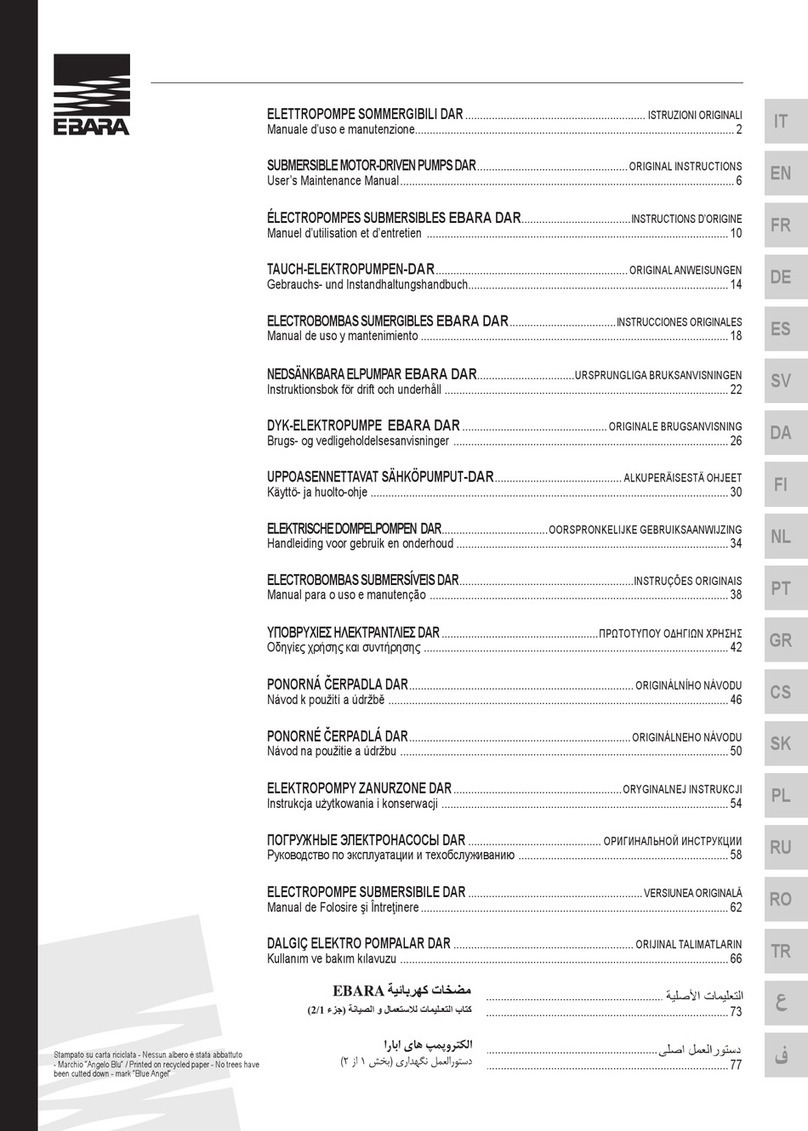
EBARA
EBARA DAR Series Original instructions
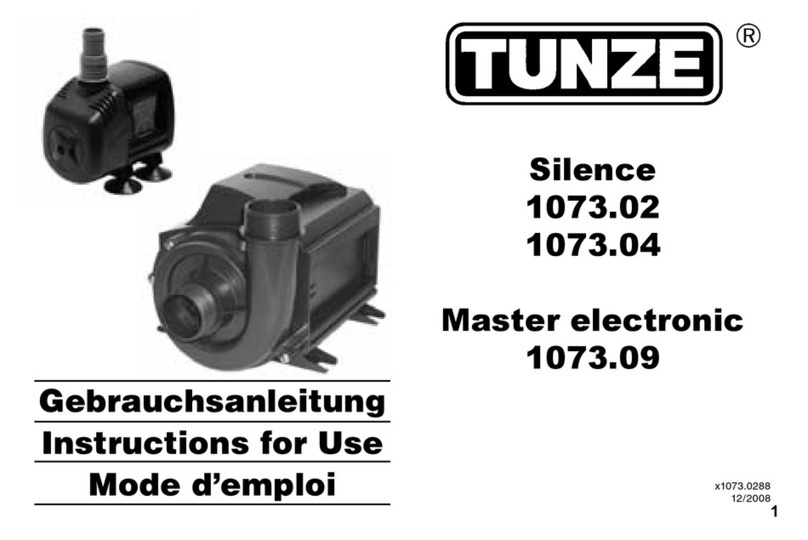
Tunze
Tunze Master electronic Instructions for use

Edwards
Edwards E2M40 instruction manual

INOXPA
INOXPA DIN-FOOD Installation, service and maintenance instructions
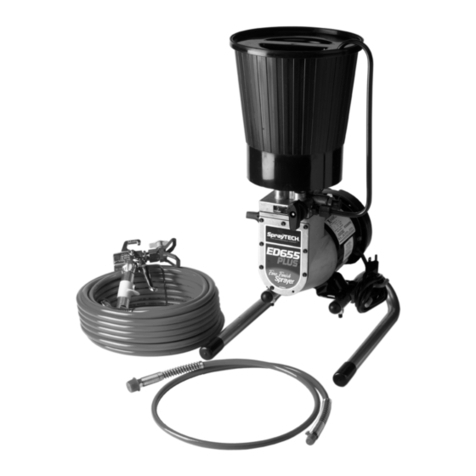
SprayTECH
SprayTECH ED655 Plus owner's manual

ProMinent
ProMinent Sigma / 2 Basic Type SBKa operating instructions
